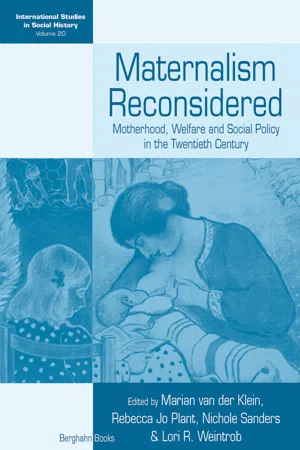History
Sheppard Towner Act
The Sheppard Towner Act, passed in 1921, was the first federal legislation in the United States to provide funding for maternal and child health programs. It aimed to reduce high infant and maternal mortality rates by supporting education and healthcare services for mothers and children. The act marked a significant step in recognizing the importance of public health initiatives for women and children.
Written by Perlego with AI-assistance
Related key terms
1 Key excerpts on "Sheppard Towner Act"
- eBook - ePub
Maternalism Reconsidered
Motherhood, Welfare and Social Policy in the Twentieth Century
- Marian van der Klein, Rebecca Jo Plant, Nichole Sanders, Lori R. Weintrob(Authors)
- 2012(Publication Date)
- Berghahn Books(Publisher)
Skocpol shows how and why the women’s movement in the United States managed to achieve so much more with its campaign for the interests of mothers and children than did the labour movement, which campaigned for social insurance for workers. The concerted efforts of the General Federation of Women’s Clubs, the National Congress of Mothers and the Women’s Christian Temperance Union – all middle-class women’s organizations – resulted in the establishment of mothers’ pensions in numerous states (1911–13), the founding of the Children’s Bureau (1912) and the passage of the Sheppard-Towner Act (1921). The mothers’ pensions were state-controlled, regular benefits for impoverished – often widowed – mothers with dependent children. The Children’s Bureau was financed by the federal government. It registered as many births as possible, as well as the socioeconomic situation of the mother and child. The aim was to improve maternal and child health and to reduce infant mortality in the United States, which was quite high compared to other industrialized nations. The Bureau, run by well-educated and reform-minded women, in turn successfully lobbied for the Sheppard-Towner Infancy and Maternity Protection Act. This federal law required states to provide expectant mothers with health information and support from professionally trained nurses.Skocpol states that the American women’s movement in the early twentieth century was a maternalist movement, though she does not precisely define the term. This maternalist women’s movement managed to capitalize on the opportunities that the middle-class doctrine of the separate spheres offered women at a time when they still lacked the right to vote. Women’s responsibility for the domestic domain formed the basis of their success in obtaining social and political power in the public domain.
Learn about this page
Index pages curate the most relevant extracts from our library of academic textbooks. They’ve been created using an in-house natural language model (NLM), each adding context and meaning to key research topics.
